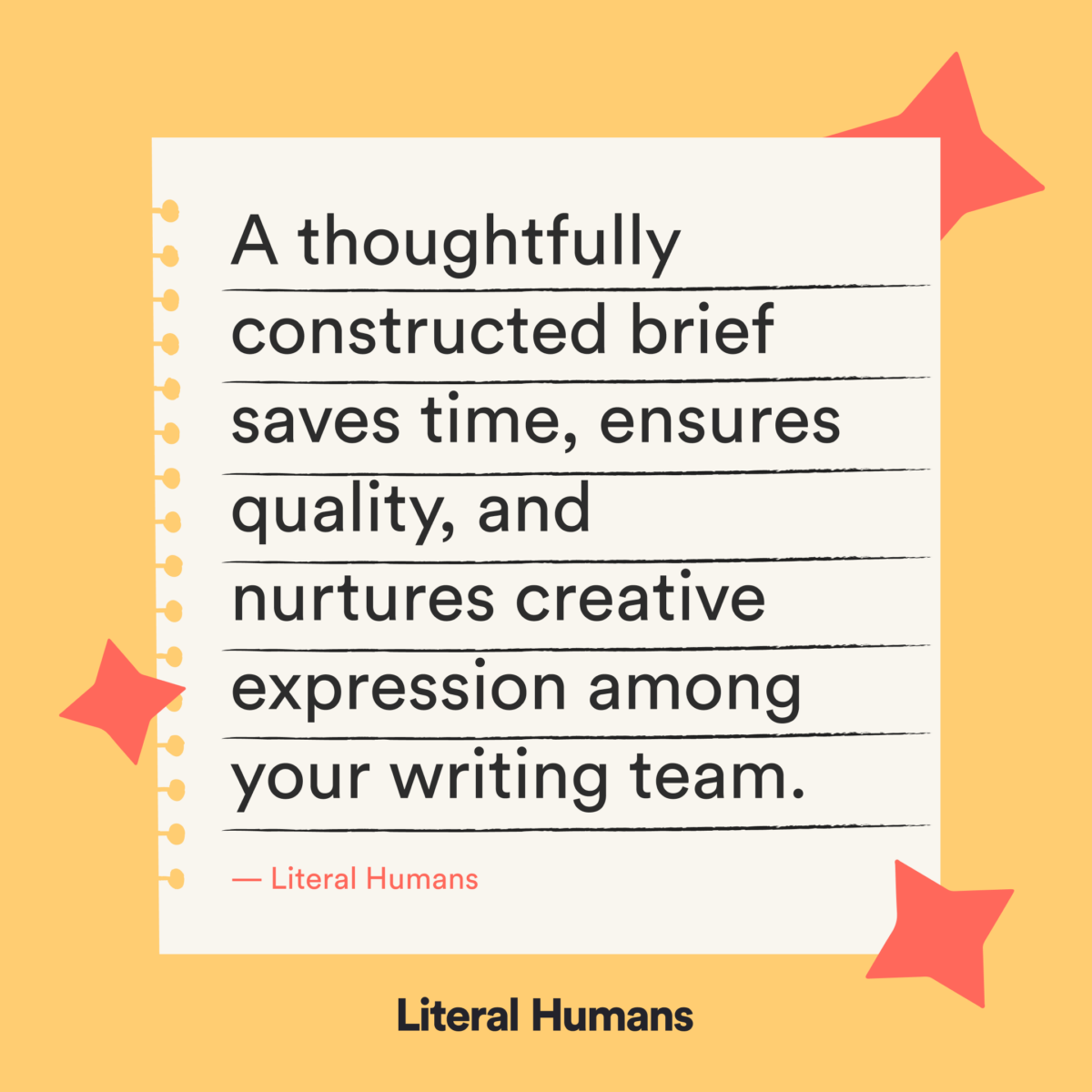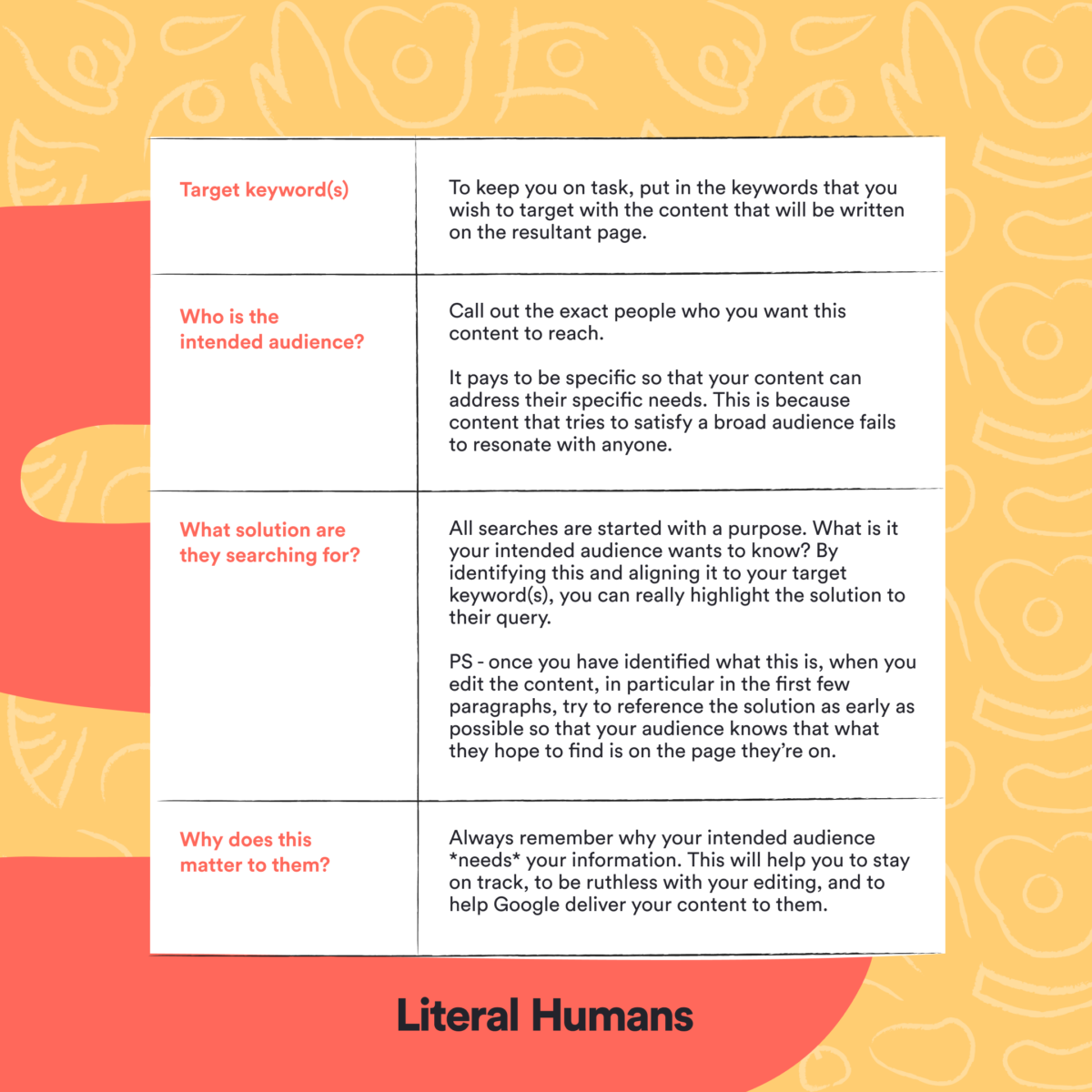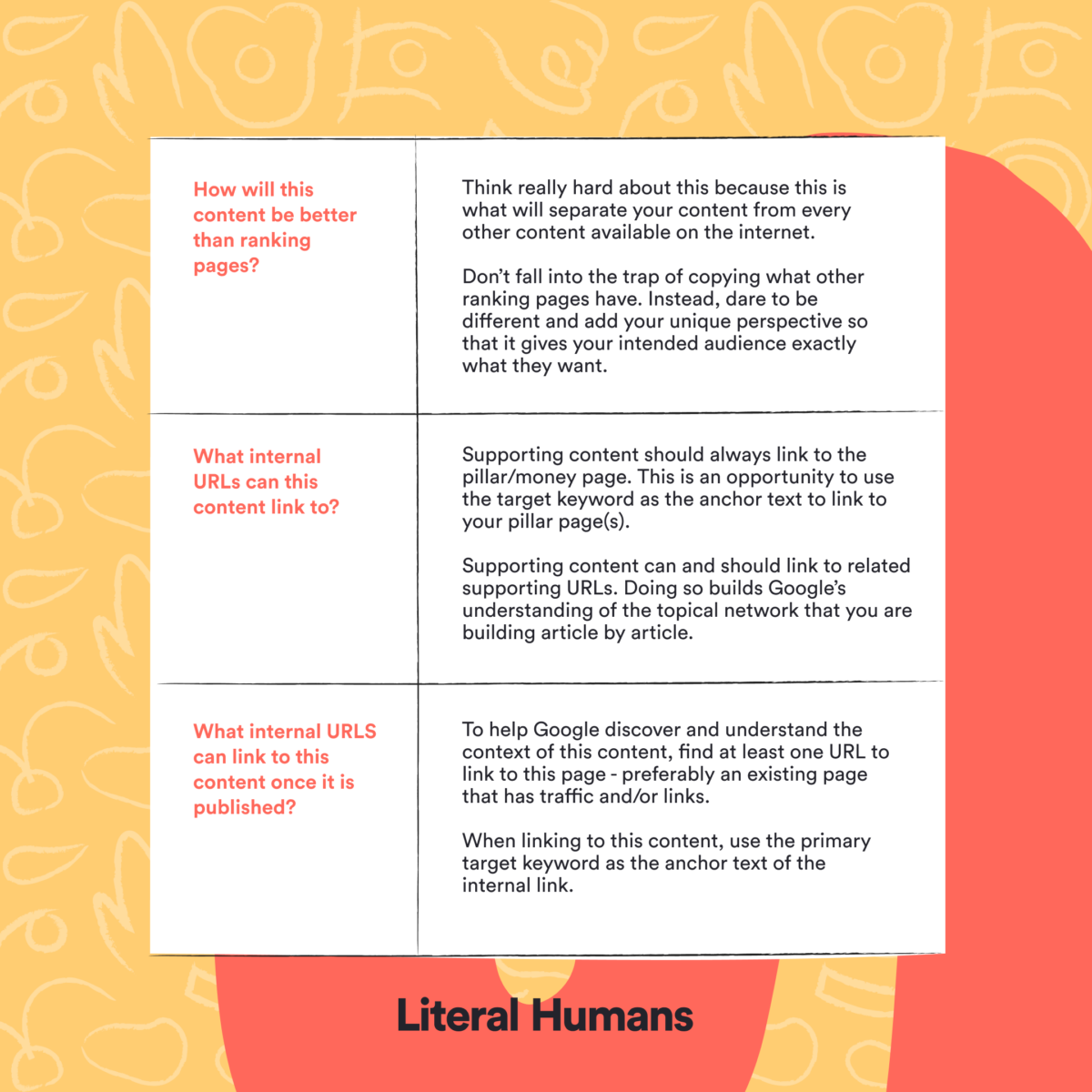Have you ever found yourself in a situation where a writer expresses uncertainty about what information to include and the appropriate tone to strike when creating a piece of content?
That’s where the content brief comes in, serving as the foundation for impactful writing. Think of it as a pre-made map, highlighting key points and areas of focus, and giving your writers that much-needed headstart to create compelling content that hits the mark.
But why limit yourself to just a content brief when you can create a reusable framework? One that saves you precious time and ensures uniformity across your content. We’re talking about a content brief template.
So, on the one hand, we have the content brief, which is essentially a set of instructions given to writers, guiding them on what to create. It’s a customized document tailored to each specific piece of content. On the other hand is the content brief template, a pre-designed framework that streamlines the briefing process, ensuring consistency and efficiency.
A content brief template is ideal for:
- Repetitive content formats: For example, blog posts, social media captions, and product descriptions.
- Standardizing information: Ensuring all essential elements of a content brief are included.
- Maintaining brand voice: Creating content with a consistent tone and style.
Below, we explore the significance of content brief templates, their key elements, and some of the most effective templates organizations and professionals use.
The key elements of a content brief template
A content brief template typically includes key elements that guide writers in creating relevant and effective content. While specific templates may vary based on your organization’s needs, preferences, target audience profiles, and more, here are some common key elements:
- Project overview: A summary outlining the purpose and scope of the content project. This section will also often feature a working title, specifying the content’s subject matter, along with defined deadlines for delivery, revisions, and feedback.
- Content goals and objectives: Clearly defined goals, objectives, and key metrics the content aims to achieve.
- Audience description: Detailed information about the target audience, including demographics, interests, pain points, and buyer’s journey stage (i.e., awareness, consideration, or decision-making).
- Key message: The core message or theme the content should convey to resonate with the audience.
- Tone and style guidelines: Instructions on the preferred tone, writing style, and voice to maintain consistency.
- Competitor analysis: Insights into competitors’ content strategies and how the new content should differentiate itself.
- Content format: A section specifying the type of content being created. For example, blog post, guest post, ebook, whitepaper, video script, infographic, etc.
- Content structure: An outline or structure for the content, specifying sections, target length for the content, and any required formatting. This outline will include suggested sections and subheadings to guide the writer, key points or information to be covered, and the expected flow and progression of the content.
- Call to action (CTA): If applicable, guidance on incorporating a compelling call to action to drive desired user actions.
- Resources and references: Links to relevant research or data sources, as well as content for inspiration.
- Visual and multimedia elements: Instructions on the inclusion of images, videos, infographics, or other multimedia elements.
- Distribution channels and platforms: Specification of the platforms or channels where the content will be published or distributed.
- SEO considerations: If applicable, guidelines for incorporating relevant keywords, search intent, metadata, and other SEO elements.
Some brief templates will also include additional notes covering specific requirements or constraints, and preferred tools or software for writing and editing.
Incorporating these essential elements into your content brief template empowers writers to craft engaging content tailored to your goals and audience. While this may seem like a lot of elements to include, keep in mind that a thoughtfully constructed brief saves time, ensures quality, and nurtures creative expression among your writing team.
Why writers love content brief template
Think of a content brief template as a personal writing coach. It supercharges your content brief so that you can do the following at scale:
- Boost clarity and focus, eliminating confusion and guesswork.
- Reduce revision rounds, ensuring content aligns with expectations from the outset.
- Empower creativity by providing direction while leaving room for individual flair.
- Enhance quality and consistency. This leads to better content output and results

Put simply, a solid content brief template results in a smoother workflow; writers can spend less time revising and more time creating content that truly shines.
Inspiring brilliance: Effective content brief templates to emulate
Now, let’s look at some effective content brief templates you can take inspiration from to create your own.
1. Daniel Cheung’s beginner-friendly content brief template

This content brief by renowned digital marketing professional, Daniel Cheung, is designed specifically for individuals and teams new to content marketing. Its user-friendly nature and detailed guidance make it an ideal tool for crafting engaging content easily.
Some of the template’s key components include target keyword(s), linking opportunities, as well as target audience and competitor analyses. The template encourages users to think deeply about their answers to each question, ensuring they thoroughly consider all aspects of the content strategy. Plus, the second half of the template provides a skeletal outline based on secondary and long-tail keywords, offering a foundational SEO structure for the content.
Why it works
- The clear instructions and detailed explanations make the template readily accessible even for individuals with limited content marketing experience. This empowers them to create high-quality content without needing extensive prior knowledge.
- The prompting questions encourage users to consider all essential aspects of the content, including target audience, keywords, and internal linking. This ensures a well-rounded and strategic approach to content creation.
- The template provides a structured outline that facilitates efficient content development. For example, converting secondary and long-tail keywords into subheaders helps users organize their thoughts and create a logical flow for their content.
Download the content brief template by Daniel K. Cheung here.

2. Hack The Box’s technical brief template
Hack The Box template is specifically aimed at helping subject matter experts to craft informative and engaging content for technical audiences, such as engineering professionals.
The template prioritizes the needs of technical audiences, ensuring the content is accurate, relevant, and in-depth enough to satisfy their knowledge requirements. It also encourages experts to present technical topics with a unique and brand-specific perspective, differentiating their content and attracting a dedicated audience.
Why it works:
- The template recognizes the technical knowledge of its users and allows experts to focus on providing valuable insights and advanced information relevant to their audience.
- The focus on brand-specific angles helps experts establish their unique voice and position themselves as authoritative figures in their field. This attracts a dedicated audience and strengthens brand recognition.
- By catering to the specific needs and interests of technical audiences, the template facilitates the creation of engaging and informative content, which leads to increased reader engagement and more impactful dissemination of knowledge.
Download HTB’s template here.
3. SEMrush SEO-focused template
The SEMrush SEO content template equips writers with actionable insights to enhance their SEO efforts and outperform the competition in the ever-evolving world of SEO. Its key components include competitor analysis, keyword insights, on-page optimization recommendations, and backlink analysis.
With its comprehensive coverage of SEO elements and data-driven approach, the template is a valuable resource for businesses and content creators seeking to achieve higher search engine rankings, attract more website visitors, and capture valuable leads.
Why it works:
SEMrush’s template is effective because it aligns with SEO best practices, offering a strategic approach to content creation. Here’s why it works:
- By identifying top competitors, the template allows you to understand the competitive landscape and tailor your content strategy accordingly.
- Recommendations for backlinks, semantic keywords, and target word count contribute to a holistic SEO strategy, optimizing content for search engines.
- Specific suggestions for title tags, meta descriptions, and H1 tags ensure that your content is not only keyword-rich but also well-optimized for on-page SEO.
4. Brafton’s concise brief template
Brafton’s template is a valuable resource for creating high-quality SEO content. While it lacks some elements typical of a complete content brief template, its clear structure and insightful explanations make it an effective tool for passing on essential information to writers. The template structure includes a description of the content format, a summary, target keywords, topics to discuss, KPIs, and distribution recommendations.
Why it works:
- The explainer text within each section provides valuable context and guidance for writers, helping them understand the content’s purpose, target audience, and desired tone. This clarity reduces confusion and ensures the final product aligns with expectations.
- The defined KPIs allow for a clear and objective assessment of the content’s performance, enabling adjustments and optimizations for future success.
- While the template lacks elements like brand and audience details, it can be easily adapted to incorporate additional information from strategists. This flexibility allows it to cater to diverse content needs and ensures a comprehensive approach.
Download the Brafton content brief template here.
5. The comprehensive Smart Blogger brief template
Smart Blogger’s content brief template provides a comprehensive and structured framework for content managers and strategists to communicate their needs to writers effectively. Although it lacks explainer instructions within each section, its detailed structure and focus on key takeaways and success criteria empower writers to deliver high-quality content.
The template covers all essential aspects of content creation, including target audience, keywords, content type, tone, and style. Writers also get a dedicated section for key takeaways and an outline for specific success criteria. These components ensure that all the necessary information is communicated to the writer for a successful outcome.
Why it works:
- The template outlines key takeaways and success criteria, ensuring alignment between the content manager’s vision and the writer’s execution. This minimizes misunderstandings and reduces the need for revisions.
- Focusing on success criteria encourages writers to create content that achieves specific objectives and contributes to measurable results. This aligns content creation with the overall content strategy and maximizes its impact.
- The flexible structure allows the template to be used for various content types, from blog posts and articles to ebooks and infographics.
- The clear and concise format of the template facilitates a smooth and efficient workflow for both content managers and writers, ensuring timely content creation and delivery while maintaining quality standards.
Download the Smart Blogger template here.
6. Agency Analytics content brief template
Agency Analytics’ content brief template stands out for its strategic focus and emphasis on helpful information for writers. Including unique components like product tie-in and internal links improves the template’s effectiveness and empowers writers to deliver high-quality, relevant content. Content focus, topic summary, competitor analysis, and reference content are the other key components of this brief template.
Why it works:
- The content focus and topic summary establish a clear direction for the content, providing a solid foundation for the writer to develop their ideas.
- The competitor analysis equips the writer with valuable knowledge about the competitive landscape, enabling them to create content that surpasses the competition.
- Inclusion of reference content reduces the writer’s research burden and provides them with readily available resources to improve their understanding of the topic.
- Product tie-in ensures the content promotes the brand seamlessly and effectively, aligning the content with overall marketing goals.
- The internal links section promotes existing content and improves website navigation, enhancing the user experience and boosting engagement.
7. Orbit Media Studios content brief template for smaller teams
Orbit Media Studio’s content brief template caters specifically to the needs of smaller teams where the writer is integrated within the marketing team. It emphasizes practical considerations and reminders for creating high-quality content, making it a valuable resource for efficient content creation.
Why it works:
- The template provides clear and concise instructions that are easily understood and implemented by writers, streamlining the content creation process.
- Focusing on scannability and visual elements ensures the content is easy to read and digest, enhancing user engagement and retention.
- By incorporating contributor quotes, the content gains additional authority and trust, making it more valuable to the target audience.
- The template encourages collaboration between writers and other marketing team members for effective content promotion across various channels.
- The emphasis on tracking URLs allows for measuring the success of content promotion efforts and making data-driven decisions for future optimization.
Download Orbit Media Studio’s template here.
8. Deel’s marketing-focused brief template
Deel’s brief template stands out for seamlessly connecting individual articles to the broader marketing strategy. This ensures that each piece of content contributes effectively to achieving overall content marketing goals.
Why it works:
- By linking each article to the overarching marketing strategy, the briefs ensure that content creation aligns with overall goals and objectives, leading to a more cohesive and impactful content ecosystem.
- Including case studies allows the content to showcase the practical benefits of using Deel, effectively demonstrating its value proposition to potential customers.
- Highlighting awards and accolades builds trust and strengthens Deel’s brand image, positioning the company as a reliable and successful business.
- Integrating data and research findings strengthens the content’s credibility and provides a factual basis for Deel’s claims, further enhancing its persuasiveness.
Make a copy of Deel’s template here.
9. Content Folks ABCD content brief template
Content Folks’ ABCD content brief template makes it onto this list because of its comprehensive nature and strong focus on providing writers with everything they need to create SEO-optimized content. While a shift from keyword to topic focus might be beneficial — focusing on the topic to be covered is a better approach than merely focusing on keywords — the sections on audience, brand, context, and details make it a valuable resource for content teams.
Here’s a breakdown of the template’s components:
- A – Audience: Identifies the target audience for the content, ensuring it is tailored to their demographics, pain points, needs, interests, key decision-making factors, and reading level.
- B – Brand: Clearly defines the brand’s goals, content angle, value proposition, and key differentiators.
- C – Context: Defines the content’s intent, relevant keywords, content format, and competing content.
- D – Details: Offers valuable information for developing the piece.
Why it works:
- The template covers all essential aspects of content creation, providing writers with a clear roadmap for crafting high-quality content.
- Emphasis on the brand’s unique selling points makes this a great template for product marketing, strengthening brand identity and recognition.
Download the ABCD template here.
10. Convince & Convert template with a focus on distribution and promotion
Convince & Convert’s content brief template distinguishes itself by including a dedicated section for distribution and promotion, a crucial aspect often overlooked in content creation.
This forward-thinking approach ensures that content gets created, reaches the intended audience, and achieves its desired impact. The template also includes other crucial components, including update frequency, audience mindset, key action, and decision journey stage.
Why it works:
- The template embraces a holistic view of content, recognizing that creation is only one part of the equation. Incorporating distribution and promotion strategies ensures the content reaches its target audience and achieves its intended purpose.
- The focus on the target audience and buyer journey ensures the content is relevant, informative, and addresses their specific needs at the appropriate stage of their decision-making process.
- The template facilitates collaboration between content creators and distribution teams, ensuring a smooth and efficient workflow from conception to publication and beyond.
Download the Convince & Convert template here.
11. Content Harmony’s content brief template
The Content Harmony template does a great job of blending high-level details with a detailed content overview, as well as audience and tone guidance. This makes for a comprehensive brief template that caters to the needs of beginner writers and seasoned pros alike.
High-level details include critical elements such as the intended title tag, H1, meta description, target audience, and estimated word count, providing a structural foundation for the content. The content overview delves into the specifics of the content, offering suggested H2s, H3s, and H4s, while audience and tone guidance guides the writer in understanding the audience and desired tone.
Why it works:
- The template strikes a balance between offering a structured foundation and allowing creative freedom, empowering writers to approach the topic with flexibility.
- The template covers crucial elements, from high-level details to detailed content specifics, ensuring writers have all the necessary information to create compelling content.
- By emphasizing audience details and the desired tone, the template recognizes the significance of tailoring content to specific readers, preventing the common pitfall of creating content that appeals to no one.
- Acknowledging that skilled writers can adapt their copy for different audiences, the template encourages writers to take strategic actions, bridging the gap between strategy and execution.
Make a copy of Content Harmony’s template here.
Top tips for creating an effective content brief template
Here are some top tips for creating an effective content brief template:
Start with a clear purpose and goal
What are you hoping to achieve with this content? What problem are you trying to solve, or what opportunity are you trying to capitalize on? A clear understanding of your purpose will guide all other aspects of the brief template.
Define your target audience
Who are you trying to reach with this content? What are their demographics, interests, and pain points? The better you understand your audience, the better you can tailor your content to resonate with them.
Choose the correct content type
Is a blog post, article, video, infographic, or something else the best format for your message? When choosing a content type, consider the goals of your content, the target audience, and the overall content strategy.
Provide clear instructions and guidelines
What tone and style should the writer use? Are there any specific brand guidelines or requirements? The more detailed your instructions are, the less room for confusion there is, and the higher the quality of the final product.
Include a call to action
What do you want the audience to do after consuming your content? Whether it’s signing up for your email list, visiting your website, or making a purchase, make sure your call to action is clear and engaging.
Be flexible and adaptable
No content brief template is perfect, so be open to making adjustments as needed. Be clear about what is absolutely essential and what is open to interpretation.
Use a consistent format and structure
This will make it easier for writers to understand your expectations and for you to review their work. Consider using a template that you can adapt for different types of content.
Get feedback on your template
Ask writers, editors, and other stakeholders to review your template and provide feedback. Their input can help you refine your template and make it even more effective.
Make sure your template is easy to use and access
Store your template in a central location where everyone involved can find it easily. For example, you can use a cloud-based tool or project management software to make it even more accessible.
Review and update your template regularly
As your content needs evolve, so too will your brief template. Make sure to review and update your template regularly to ensure it remains effective.
With these tips in mind, you can create a content brief template that not only aligns with your goals but also produces high-quality content that resonates seamlessly with your target audience.
Content brief template — is it worth using?
The value of a content brief template cannot be overstated. From streamlining the writing process at scale to boosting your writing team’s efficiency, a content brief template can help your writers navigate the complexities of their projects with confidence, fostering productivity and elevating the overall quality of their work.
That said, achieving marketing and brand excellence extends beyond content briefs and templates. Enter the brand brief, a vital tool for aligning with business goals and communicating brand identity effectively.
The good news is that you don’t have to navigate the intricacies of understanding and creating a brand brief on your own. Explore Brand brief: 5 steps to outline your company vision and values to learn more about how to use this document to communicate your brand’s essence and ensure consistency across all brand touchpoints.










